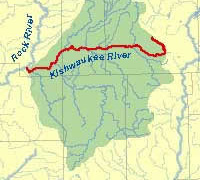Choose another river
Kishwaukee River

©Illinois State Water Survey
The Kishwaukee River Basin covers an area of approximately 1,218 square miles, spanning seven counties in northern Illinois, including parts of Boone, McHenry, Kane, DeKalb, Ogle, and small parts of Lee and Winnebago counties. The mainstem of the river empties into the Rock River about 3 miles south of Rockford, Illinois. It is formed by two branches which unite just south and west of Cherry Valley, IL. The North Branch arises in east-central McHenry County and flows to the west to near Rockford, where it turns south before uniting with the South Branch. The South Branch has its origin on a moraine just north of Shabbona. It flows northeasterly to the village of Genoa, where it turns to the northwest before uniting with the North Branch The two branches thus united, then flow only a short distance before emptying into the Rock River.
More than 60 species of fish have been found in the Kishwaukee River Basin, including several species of sport fish. The most sought after of the sport fish are the smallmouth bass and channel catfish, with both found abundantly and of good size. Panfish such as bluegill and rock bass can be found in some areas of the river, along with largemouth bass. Northern pike can also be found in several areas, but in low numbers.
Note: The Kishwaukee is NOT public, so it can only be accessed in areas where the landowner allows public access. In addition, there are many areas on the Kishwaukee that are owned by park districts and/or conservation districts. These entities DO allow boating, canoeing, and fishing on their portion of property. However, you need to be careful of where their boundary ends to avoid trespassing on private property where the owner does not allow the public.
Fishing Outlook ( Full PDF Report )
Click here for a list of all reports.
Species |
Rank |
Fish Status |
Average | Bluegill can be found throughout the Kishwaukee River system but generally in low numbers due to a lack of suitable backwaters. Best populations have been found in the South Branch of the Kishwaukee near DeKalb and Sycamore, or upstream of the dam at Belvidere where the water is impounded. Rock bass are commonly found in the rocky areas, downstream of the Belvidere dam. The largest number have been found near the Kishwaukee River Forest Preserve south of Rockford where several individuals greater than 8" in total length were collected. | |
Good | Channel catfish are abundant and of good size in the North Branch of the Kishwaukee River below the Belvidere dam, all the way down to the confluence with the Rock River south of Rockford. They can also be found in the South Branch of the Kishwaukee River, especially near the confluence with the North Branch south of Rockford. A study done in 2016 found that the average length of the channel catfish collected from the Kishwaukee River was 14.2" with the largest at 18". The average weight of these fish was 1.2 pounds with the largest at 2 pounds. Very few channel catfish occur upstream of the dam in Belvidere, due to the dam blocking upstream migration. Channel catfish have been stocked above this dam, but they have failed to establish permanent residence. | |
Very Good | Smallmouth bass are common and abundant in the Kishwaukee River. In 2016 a basin wide survey was conducted on the Kishwaukee River. A total of 67 smallmouth bass were collected during this survey with the largest number collected downstream of the Belvidere Dam, west of Belvidere, Illinois. The largest fish collected were over 18" in total length and weighed 3 pounds. Fifty four percent of the population were over 11" in total length with 24% over 14", which bodes well for fishermen. The largest fish, those over 16", accounted for 7% of the population! The best fishing can be found a few miles downstream of the Belvidere Dam as well as south of Rockford in the Kishwaukee Forest Preserve. | |
Fishing Regulations: *Consult the current Illinois Fishing Regulations Booklet for more detailed information.
Species |
Creel Limit |
Minimum Length Limit |
Black Bass (Largemouth, Smallmouth) Entire river including tributaries in State of Illinois. |
6 singly or in combination with no more than 3 smallmouth bass in the daily creel |
14" for Smallmouth Bass |
Walleye, Sauger, or Hybrid Walleye Wisconsin state line downstream to the Sears and Steel dams at Milan |
6 either singly or in combination |
14"minimum length limit |
Walleye, Sauger, or Hybrid Walleye Sears and Steel dams downstream to confluence with Mississippi River, State of Illinois (Rock Island County). |
6 fish daily creel with no more than 1 walleye greater than 27" in total length |
15" minimum length limit with a 20-27" protected Slot Length Limit. |
Northern Pike |
3 fish daily creel |
24" minimum length limit |
Note: There is a closed season on smallmouth bass. All smallmouth bass caught between April 1 and June 15 must be immediately released alive and in good condition back into the waters from which they came.



